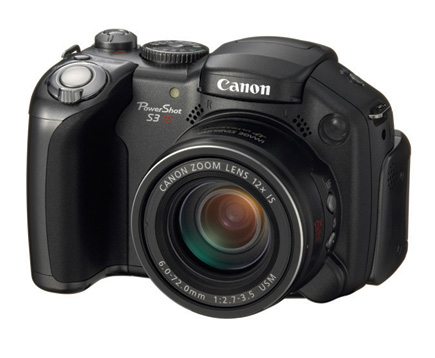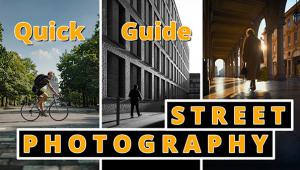Digicams; Integral Lens And “Point-And-Shoot” Digital Cameras Page 2
Long Zooms And Image Stabilizers
Although they tend to be quite large and heavy, digicams with 10x and 12x zooms
are increasingly popular, especially the models equipped with an Optical Image
Stabilizer (OIS). Do note, however, that very few of the "superzoom"
cameras include high-speed tracking focus and most can be slow to focus in low
light at long focal lengths. All employ an electronic viewfinder that's
less than ideal for following a moving subject while trying to shoot a series
of images.
The most significant development here is downsizing, started by Panasonic. The
smallest superzoom camera on the market, the (7.3 oz) Lumix DMC-TZ1 employs
folded optics technology so the 35-350mm Leica DC zoom barely protrudes from
the barrel. Like all current Lumix models--including the tiny 6-megapixel
DMC-FX01 with a 28-120mm Leica DC zoom--this one incorporates the Mega
OIS with two modes: continuous and "activated just before shutter release."
The nine-point AF sensor is great for off-center subjects but select the three-point
sensor and High-Speed AF for the most reliable performance. While the 2 fps
Burst mode is not super fast, the Lumix DMC-TZ1 offers high ISO options with
superior noise reduction and a brand-new Linear AF system. The latter provides
increased speed, useful in Continuous AF when shooting a moving subject.
 |
|
|
Replacing the (5-megapixel) S2 IS, the 6-megapixel Canon PowerShot S3 IS ($499, list) incorporates the same 36-432mm zoom that includes both aspherical and ultra low dispersion elements plus the same OIS. Canon provides three IS options: Full Time stabilization, Panning IS for long exposures while moving the camera, and Shoot Only IS that's activated only a split second before a photo is taken. The PowerShot S3 IS also provides new features: higher ISO options (to ISO 800) for faster shutter speeds to "freeze" a moving subject, a larger 2" vari-angle LCD screen, a 16:9 widescreen recording option, and an additional Sports Program mode. Its nine-point AF sensor (for capturing an off-center subject), Continuous AF mode, and fast 2.3 fps Burst mode make this full-featured camera useful for action photography.
 |
|
|
An increasing number of Sony Cyber-shot models are also available with a Super SteadyShot OIS. These include the very well specified 7-megapixel Cyber-shot DSC-H5 ($499, list) and 6-megapixel DSC-H2 ($399, list) with 36-432mm Carl Zeiss zooms, ISO options up to 1000, three-point AF sensor, and a Continuous AF mode. The OIS is also available in the new 6-megapixel Kodak EasyShare Z612 ($399, street), a camera with a 35-420mm Schneider-Kreuznach zoom, multi-point AF, Continuous AF, 2 fps Burst mode, and a long list of advanced capabilities.
 |
|
|
While an OIS is most valuable in a camera with a long lens, this feature is also becoming more readily available in digicams with shorter zooms. For example, Sony has added a Super SteadyShot stabilizer to two very compact cameras, making them more useful in very low light, in a museum or a cathedral, for example.
 |
|
|
The 7-megapixel Cyber-shot DSC-W70 (7/8" thick, $299, list) and the
8-megapixel DSC-W100 (1" thick, $349, list) include 38-114mm Carl Zeiss
zooms, five-point AF sensors, and ISO options up to 1000 and 1250, respectively.
In the Nikon line, the full-featured 8-megapixel Coolpix P3 ($449, list) and
Coolpix P4 ($399, list) with 36-126mm zooms, employ a Vibration Reduction (VR)
system originally developed for AF Nikkor lenses. Two modes are available: Normal
and VR Active that compensates for more pronounced movements, while shooting
from a moving vehicle, for example.
The smallest Canon camera ever to include a stabilizer, the new 6-megapixel
PowerShot SD700 IS Digital ELPH is equipped with a new 35-140mm zoom that employs
Canon's Ultra-High Refractive Index Aspherical (UA) lens technology, allowing
for a very compact lens that corrects aberrations. The OIS system is said to
allow for shooting at shutter speeds up to three stops slower with no perceptible
increase in image blur. This Digital ELPH ($499, list) is a surprisingly full-featured
camera considering its petite size (1" thick) with amenities such as a
nine-point AF sensor, a 2 fps Burst mode that can take numerous shots in a sequence,
plus an ISO 800 option.
Other Blur Prevention Features
By now, it should be apparent that high ISO options are becoming increasingly
common. In the past, ISO 400 was usually the uppermost limit in full-resolution
capture, but that's changing thanks to more effective noise-reduction
processors such as Canon's DIGIC II with advanced algorithms. Naturally,
image quality at high ISO varies depending on the type of system used by the
manufacturer. Frankly, some of the new cameras produce images that are excessively
smooth in my estimation, but that effect is preferred by some consumers over
coarse "grain" and mottled color specks.
Although I have mentioned only a few of the new cameras with high ISO options,
others offer high sensitivity as well, such as the waterproof 6-megapixel Pentax
Optio W10 ($279, street) with 3x optical zoom. Even some of the cameras with
OIS now provide ISO options to at least ISO 800, including the new Panasonic
Lumix and Canon PowerShot IS models as well as the new Sony DSC-H and DSC-W
series cameras with Clear RAW noise-reduction technology. Do note that my comments
refer to high ISO available in full-resolution capture; many digicams provide
high, or ultrahigh, sensitivity levels in lower resolution modes.
At this time, the new 6-megapixel Fujifilm FinePix F30 boasts the highest sensitivity
level--ISO 3200--at full resolution. This very versatile model ($399,
list), with 36-128mm optical zoom, takes advantage of new technology, including
the sixth-generation Super CCD HR and Real Photo Processor II, a combination
said to dramatically reduce digital noise. For maximum simplicity in getting
blur-free photos, select the "Picture Stabilization" mode that automatically
sets a suitable high ISO level for fast shutter speeds.
The Olympus Stylus 710 and 810-- 7- and 8-megapixel cameras, with 3x optical
zooms and TruePic TURBO processors--take a similar approach. In the "Digital
Image Stabilization" Program, the cameras automatically set a very high
ISO level: up to ISO 1600 in full-resolution capture. As an extra measure to
"freeze" any motion--and to provide better exposures with more
distant subjects--flash output is also doubled.
- Log in or register to post comments

































